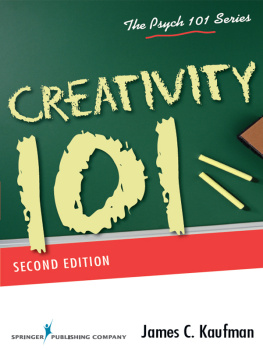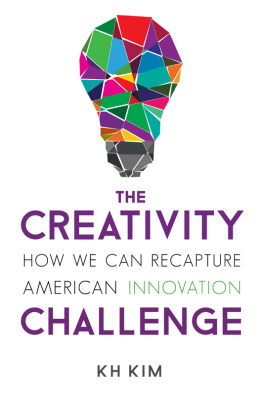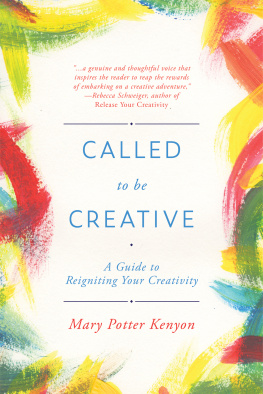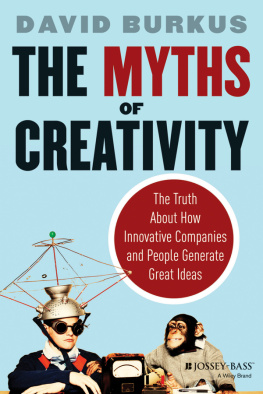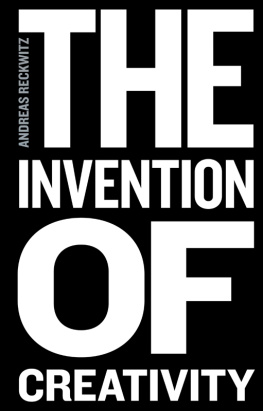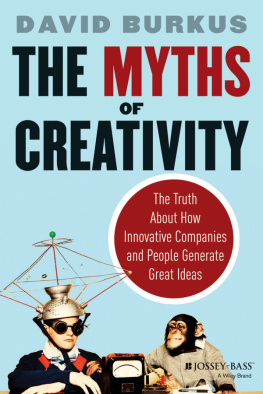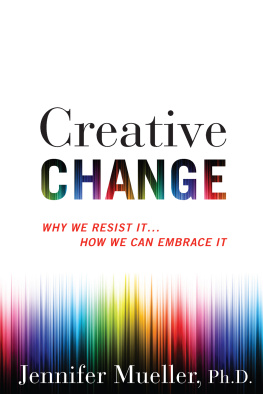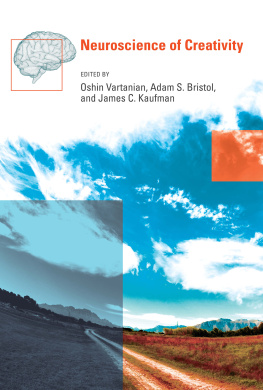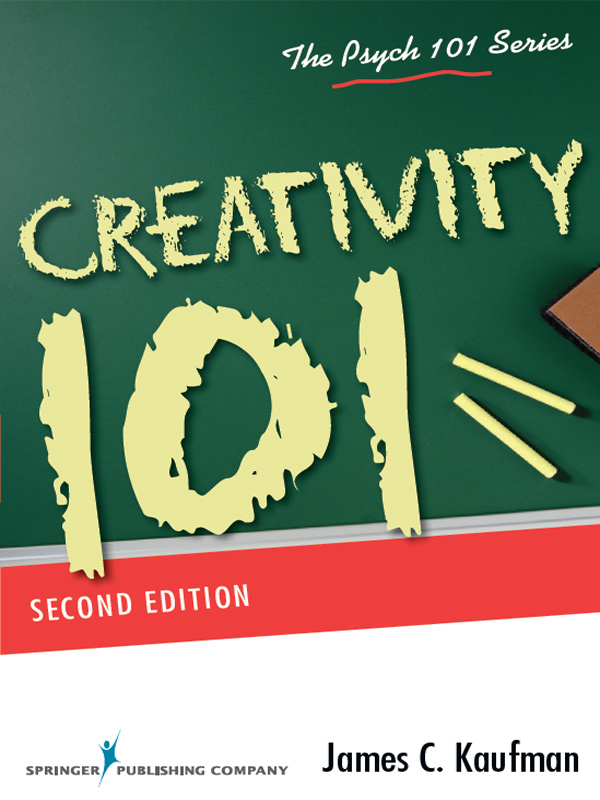Contents
Guide

James C. Kaufman, PhD , is a professor of educational psychology at the Neag School of Education at the University of Connecticut. An internationally recognized leader in the field of creativity, he is the author/editor of more than 35 books, including the Cambridge Handbook of Creativity (2010) and Teaching for Creativity in the Common Core Classroom (2014), and more than 250 papers. Dr. Kaufman was a cofounding editor of both Psychology of Aesthetics, Creativity, and the Arts and Psychology of Popular Media Culture; he currently edits the International Journal of Creativity and Problem Solving. He has won the Torrance Award from the National Association for Gifted Children, the Berlyne and Farnsworth Awards from the American Psychological Association (APA), and Mensas research award. A former president of APAs Division 10, Dr. Kaufman is a popular media expert on creativity. He has appeared on CNN, on NPR, at the 92nd Street Y, and in Redesign My Brain, and narrated the comic book documentary Independents. He is also a playwright/lyricist whose musical Discovering Magenta made its New York City debut in 2015.

Copyright 2016 Springer Publishing Company, LLC
All rights reserved.
No part of this publication may be reproduced, stored in a retrieval system, or transmitted in any form or by any means, electronic, mechanical, photocopying, recording, or otherwise, without the prior permission of Springer Publishing Company, LLC, or authorization through payment of the appropriate fees to the Copyright Clearance Center, Inc., 222 Rosewood Drive, Danvers, MA 01923, 978-750-8400, fax 978-646-8600, .
Springer Publishing Company, LLC
11 West 42nd Street
New York, NY 10036
www.springerpub.com
Acquisitions Editor: Nancy S. Hale
Composition: S4Carlisle Publishing Services
ISBN: 978-0-8261-2952-9
e-book ISBN: 978-0-8261-2953-6
16 17 18 19 20 / 5 4 3 2 1
The author and the publisher of this Work have made every effort to use sources believed to be reliable to provide information that is accurate and compatible with the standards generally accepted at the time of publication. The author and publisher shall not be liable for any special, consequential, or exemplary damages resulting, in whole or in part, from the readers use of, or reliance on, the information contained in this book. The publisher has no responsibility for the persistence or accuracy of URLs for external or third-party Internet websites referred to in this publication and does not guarantee that any content on such websites is, or will remain, accurate or appropriate.
Library of Congress Cataloging-in-Publication Data
Names: Kaufman, James C., author.
Title: Creativity 101/James C. Kaufman, PhD.
Description: Second edition.|New York: Springer Publishing Company, [2016] | Includes bibliographical references and index.
Identifiers: LCCN 2015051152 | ISBN 9780826129529
Subjects: LCSH: Creative ability.
Classification: LCC BF408 .K364 2016 | DDC 153.3/5--dc23 LC record available at http://lccn.loc.gov/2015051152
Special discounts on bulk quantities of our books are available to corporations, professional associations, pharmaceutical companies, health care organizations, and other qualifying groups. If you are interested in a custom book, including chapters from more than one of our titles, we can provide that service as well.
For details, please contact:
Special Sales Department, Springer Publishing Company, LLC
11 West 42nd Street, 15th Floor, New York, NY 10036-8002
Phone: 877-687-7476 or 212-431-4370; Fax: 212-941-7842
E-mail:
Printed in the United States of America by Gasch Printing.
I dedicate this edition, like the first edition, to my mentor and advisor, Dr. Robert J. Sternberg, who has continued to be a source of advice, inspiration, and perspective, even when he doesnt have to do so anymore.
Contents
Acknowledgments
T his book is a revision of the first edition. Much has happened (in the field and in my life) since the book first came out in 2009. I would like to start by acknowledging the many people at Springer who have made this book and the 101 Series a reality. Phil Laughlin, now at MIT Press, first signed the book and came up with the concept. Jennifer Perillo, now at Columbia University Press, also helped in the development of the series, and Nancy S. Hale is now the editor in charge. Many thanks to them, Rose Mary Piscitelli, and everyone else at Springer.
Many, many people helped with the first edition, and I thank them all. Writing this second edition has felt more like writing a new work than a revision; some sections are intact, but much has been a completely new journey. About two-thirds through the process, my hard drive crashed. It was lost, and Id managed not to back up anything for the eight previous months. Thankfully, Id e-mailed the book to someone the day beforebut all of my new references were lost. I debated pioneering a new, reference-less approach to the material, but instead found two graduate students who helped make this new edition possible by compiling all of the referencesa very special thank you to Cody Hatcher and Xiaochen Liu. My past and present UConn PhD students (Paul J. Barnett, Sarah R. Luria, and Lamies Nazzal) have also given helpful feedback and insight.
I reached out to several friends during the writing of the first edition, and I decided to double down for this edition. I sent sentences, paragraphs, sections, and the entire dang manuscript to many world-class experts in all aspects of creativity. Many thanks to Roger Beaty, Ron Beghetto, David Cropley, Dan Fasko, Marie Forgeard, Thalia Goldstein, Richard Hass, Catrinel Haught, Beth Hennessey, Alan Kaufman, Nadeen Kaufman, Yoed Kenett, Alex McKay, Jonathan Plucker, Jean Pretz, Mark Runco, Dean Keith Simonton, Robert Sternberg, Christa Taylor, Thomas Ward, and Dasha Zabelina for offering advice, answering questions, correcting mistakes, and bringing new work to my attention. Extra-special thanks to Matthijs Baas, Mathias Benedek, Bonnie Cramond, Colin DeYoung, Jessica Hoffman, Roni Reiter-Palmon, Judith Schlesinger, and Oshin Vartanian for detailed and incisive critiques and discussions in their areas of expertise above and beyond the call of duty. Finally, I was lucky enough to have a few trusted friends and gifted scholars collate the entire book word for word, offering commentary, advice, and suggestions, and even catching stupid typos. Eternal gratitude to John Baer, Vlad Glveanu, Maciej Karwowski, Scott Barry Kaufman, and Zorana Ivcevic Pringle.
In between the first edition and the second edition, I moved across the country to the University of Connecticut. Many thanks to Program Coordinator Catherine Little, Department Head Del Siegle, and Vice Provost Sally Reis and Joseph Renzulli. My dear friend Jonathan Plucker (now at Johns Hopkins) helped bring me out to UConn. I now have the pleasure of working with a team of great students and faculty, including my trusted collaborator and friend Ron Beghetto.
As I finished this new edition, I also saw my musical, Discovering Magenta, finally make its New York City debut after so many years; revisiting my own creativity with my composer Michael Bitterman, director Valeria Cossu, and the cast and crew has been a profound and terrifying experience. After more than a decade, I am once again working on new plays.

